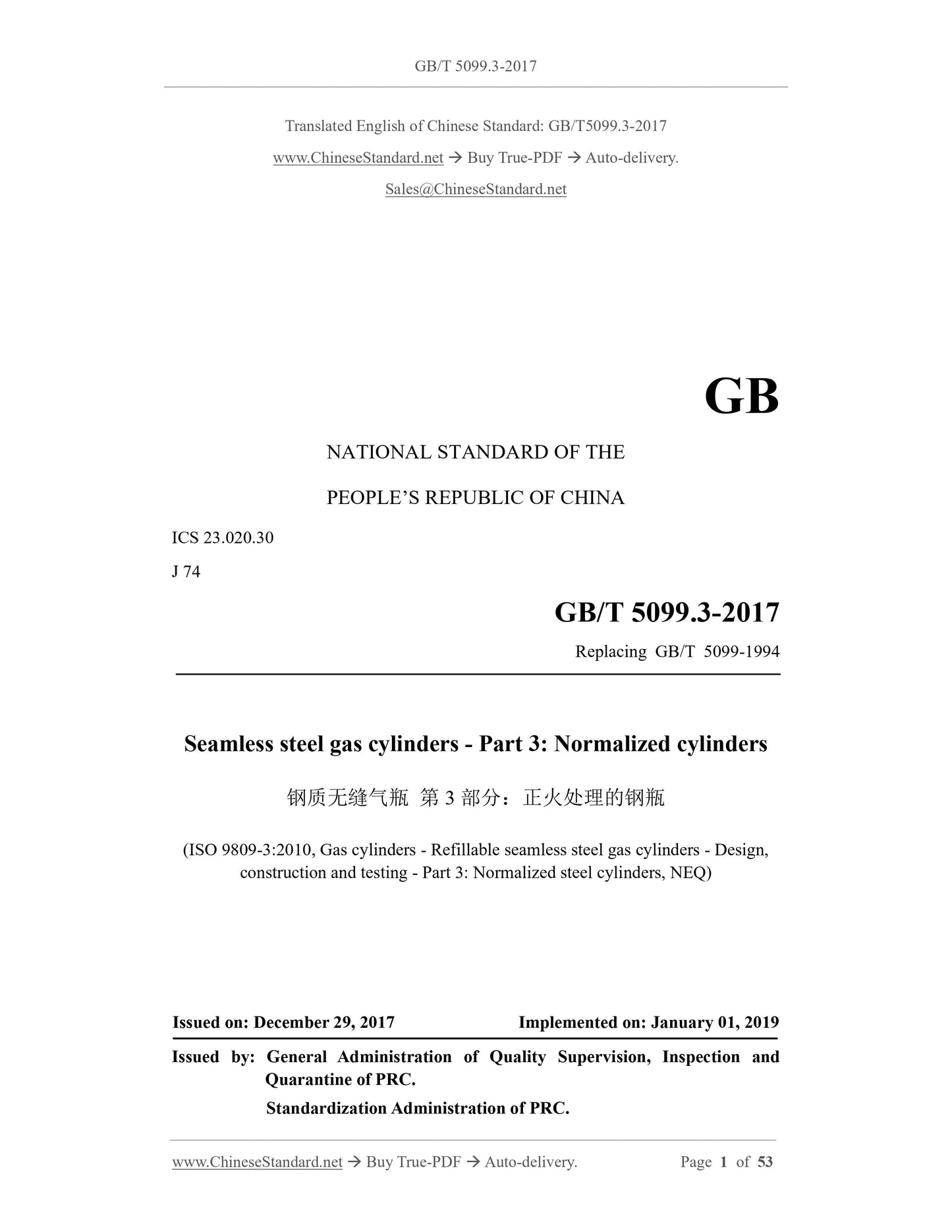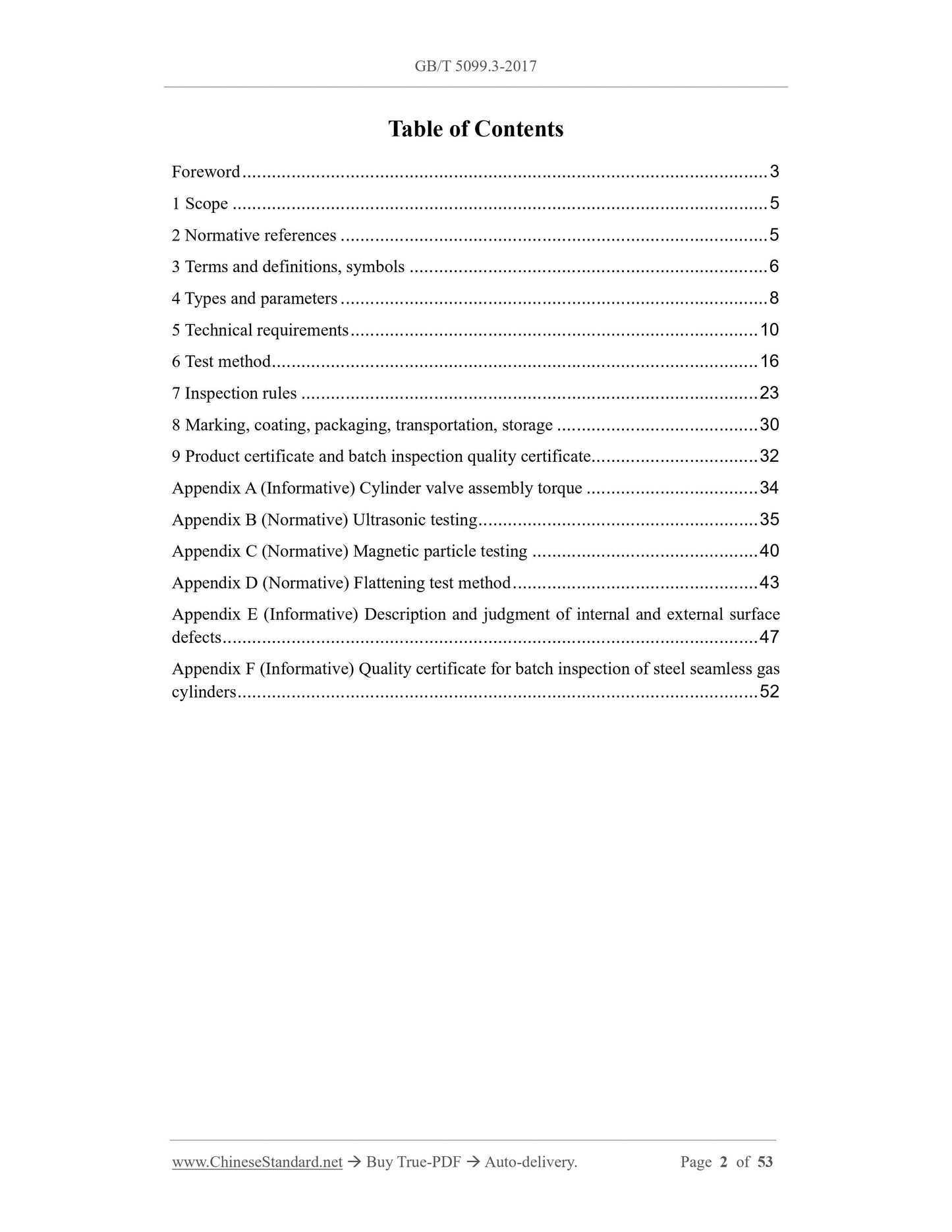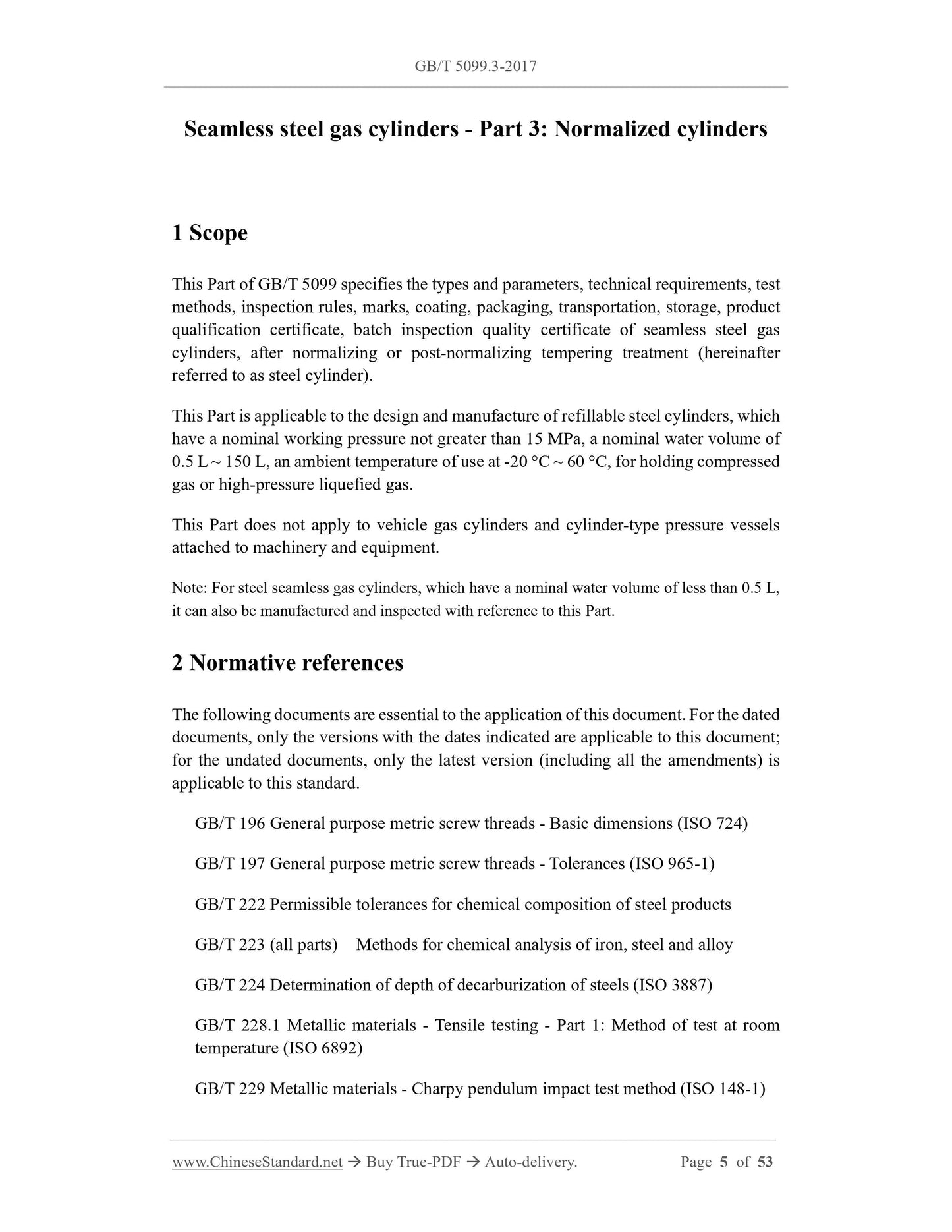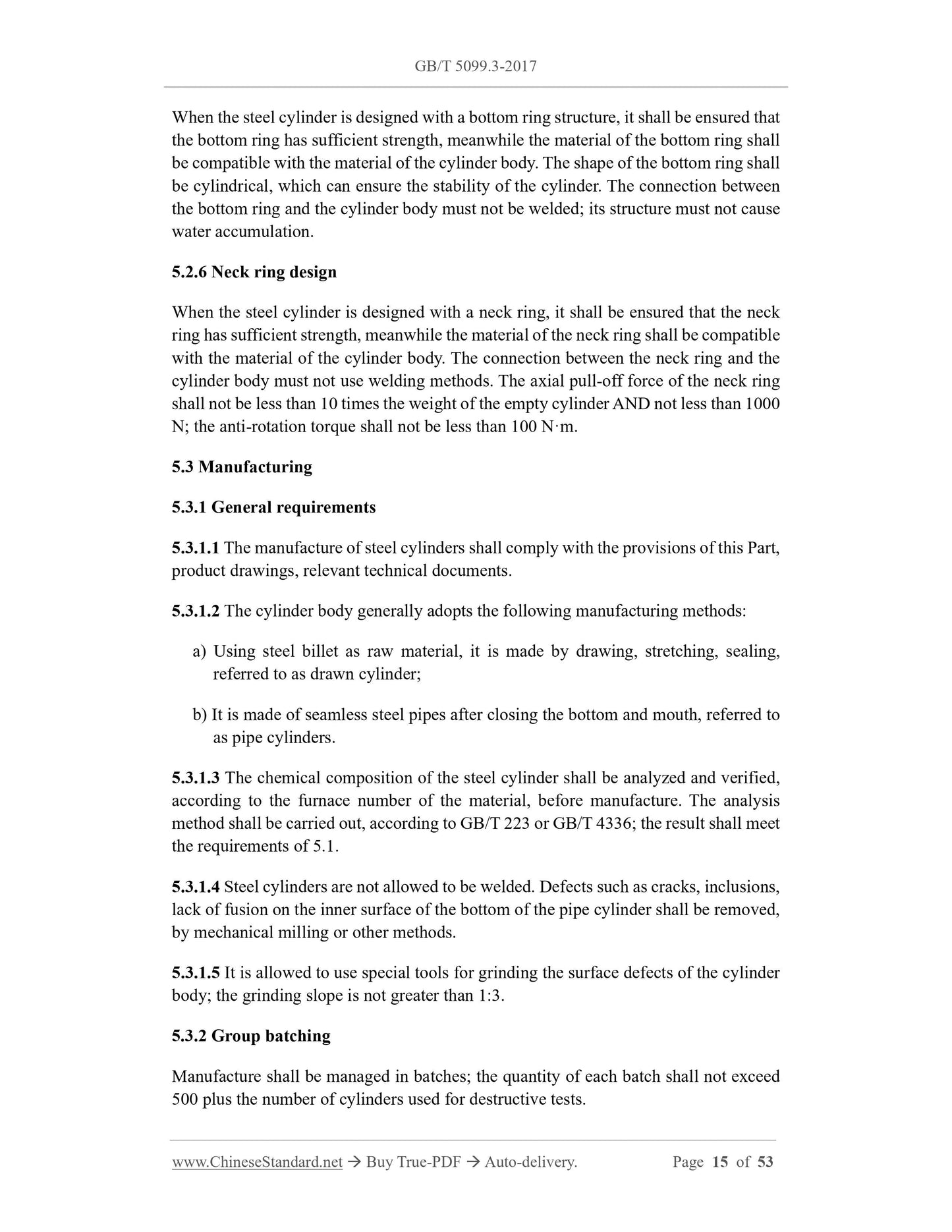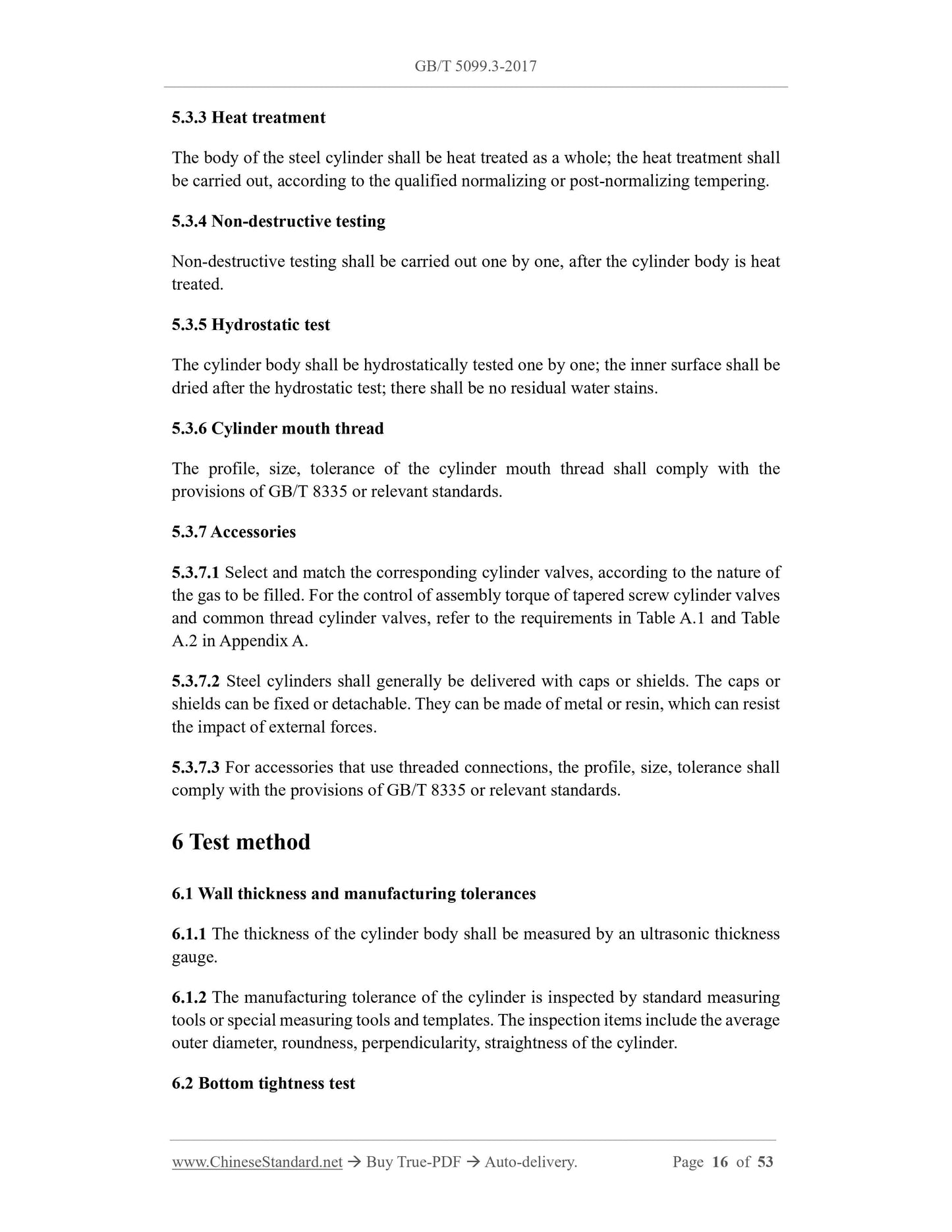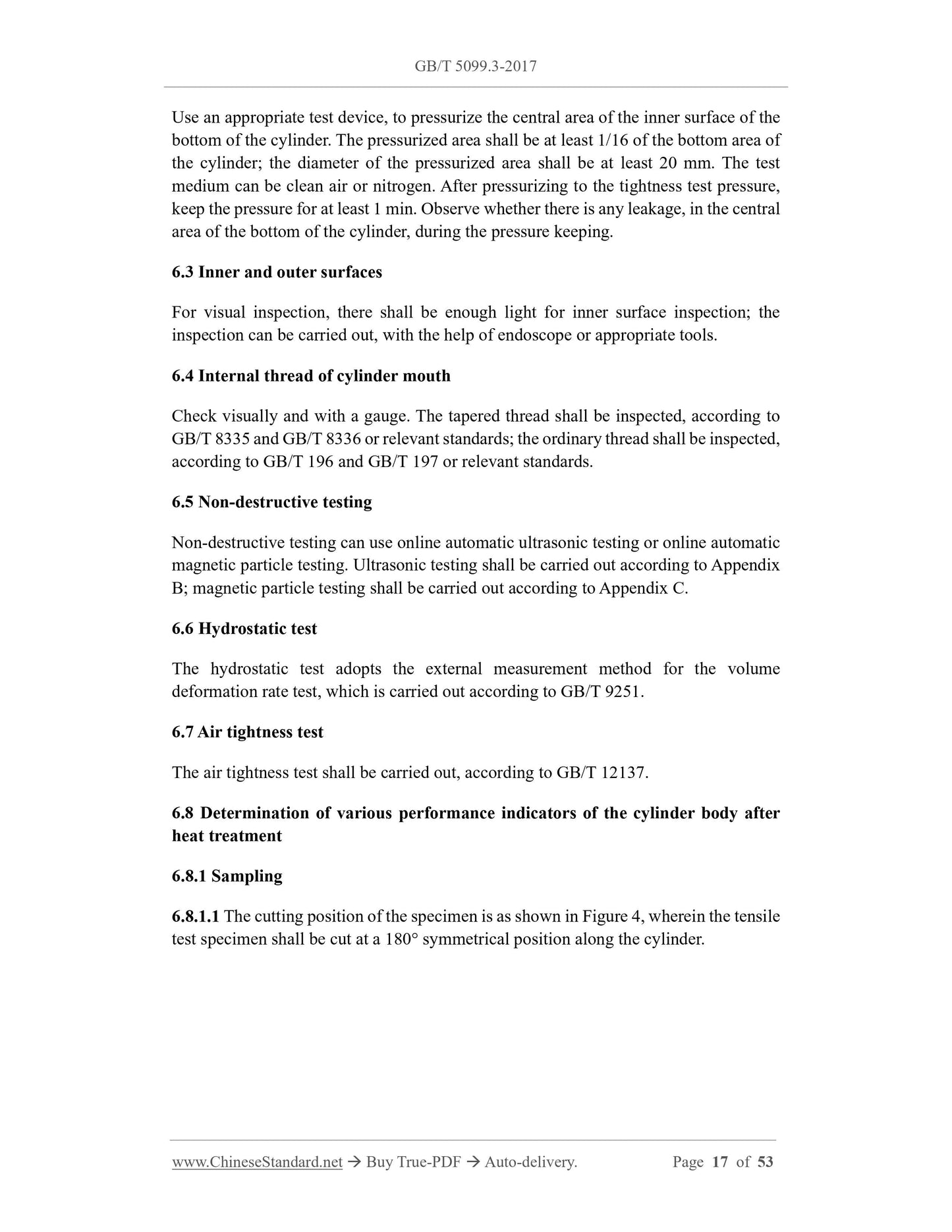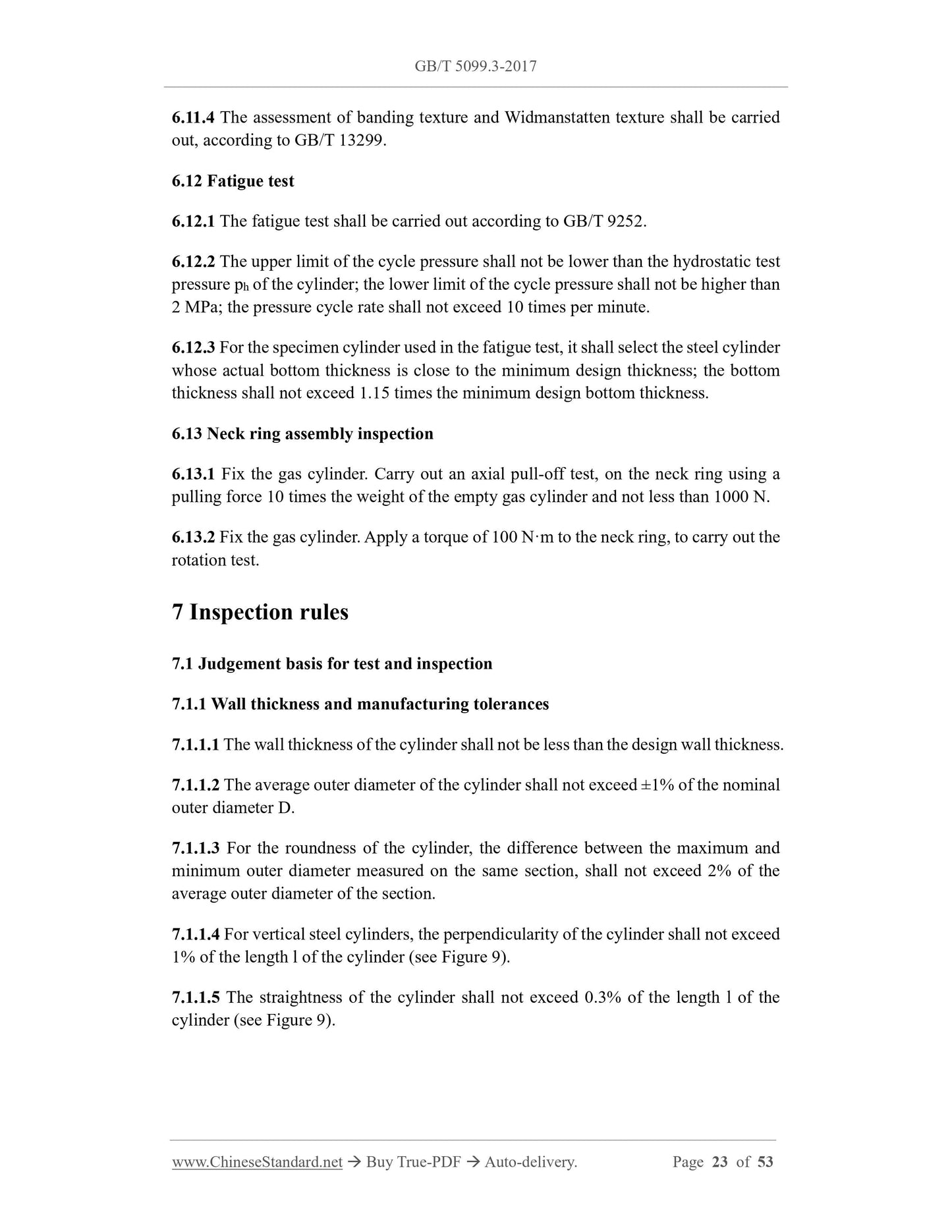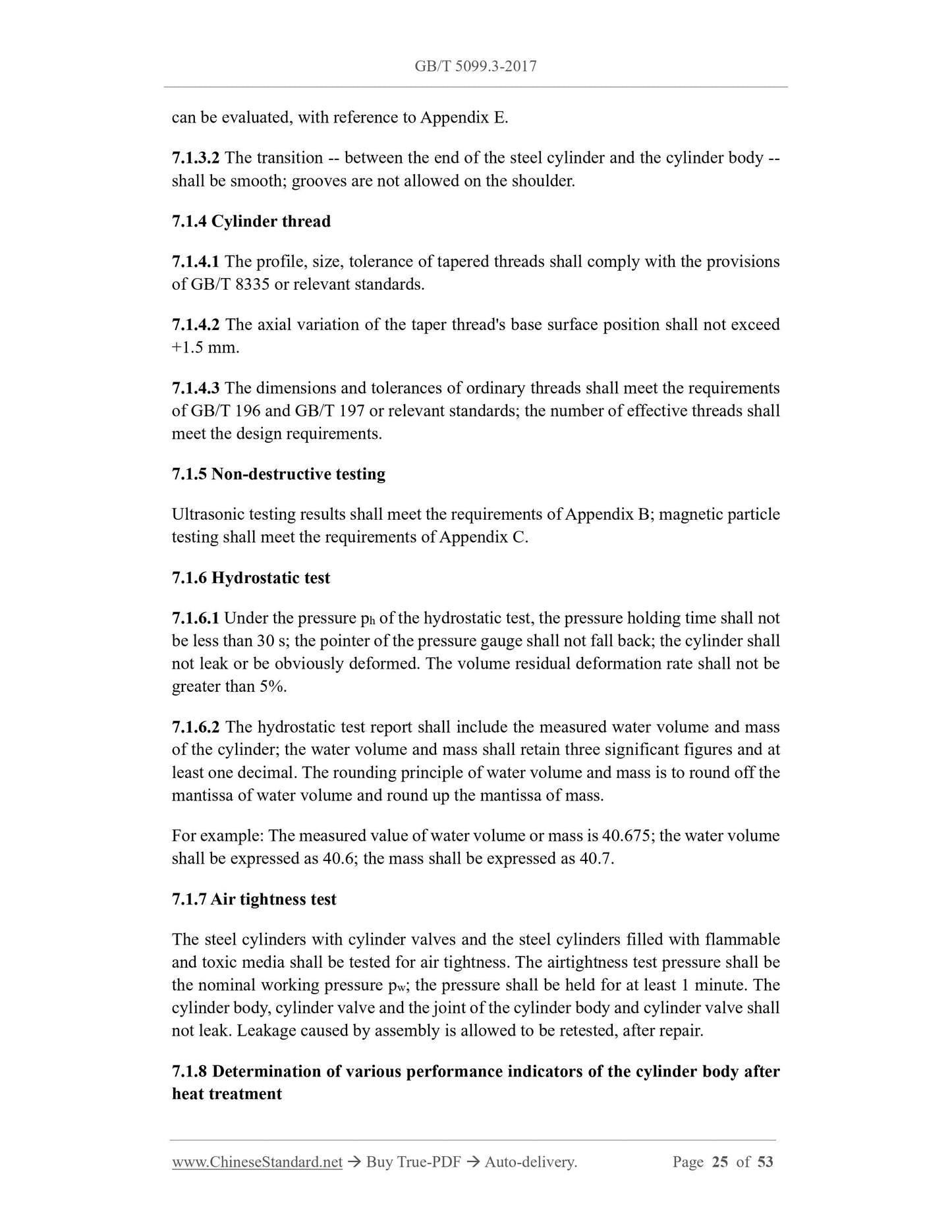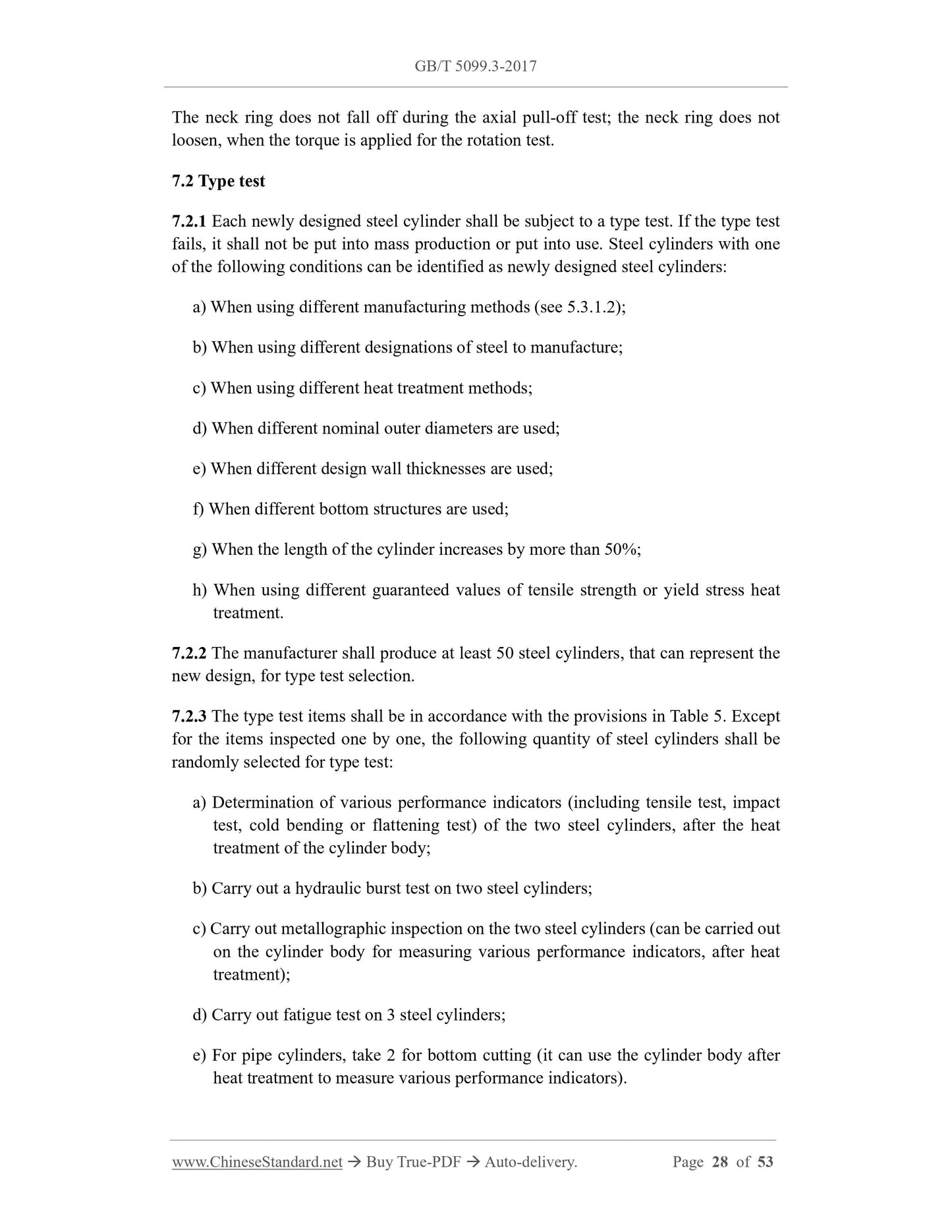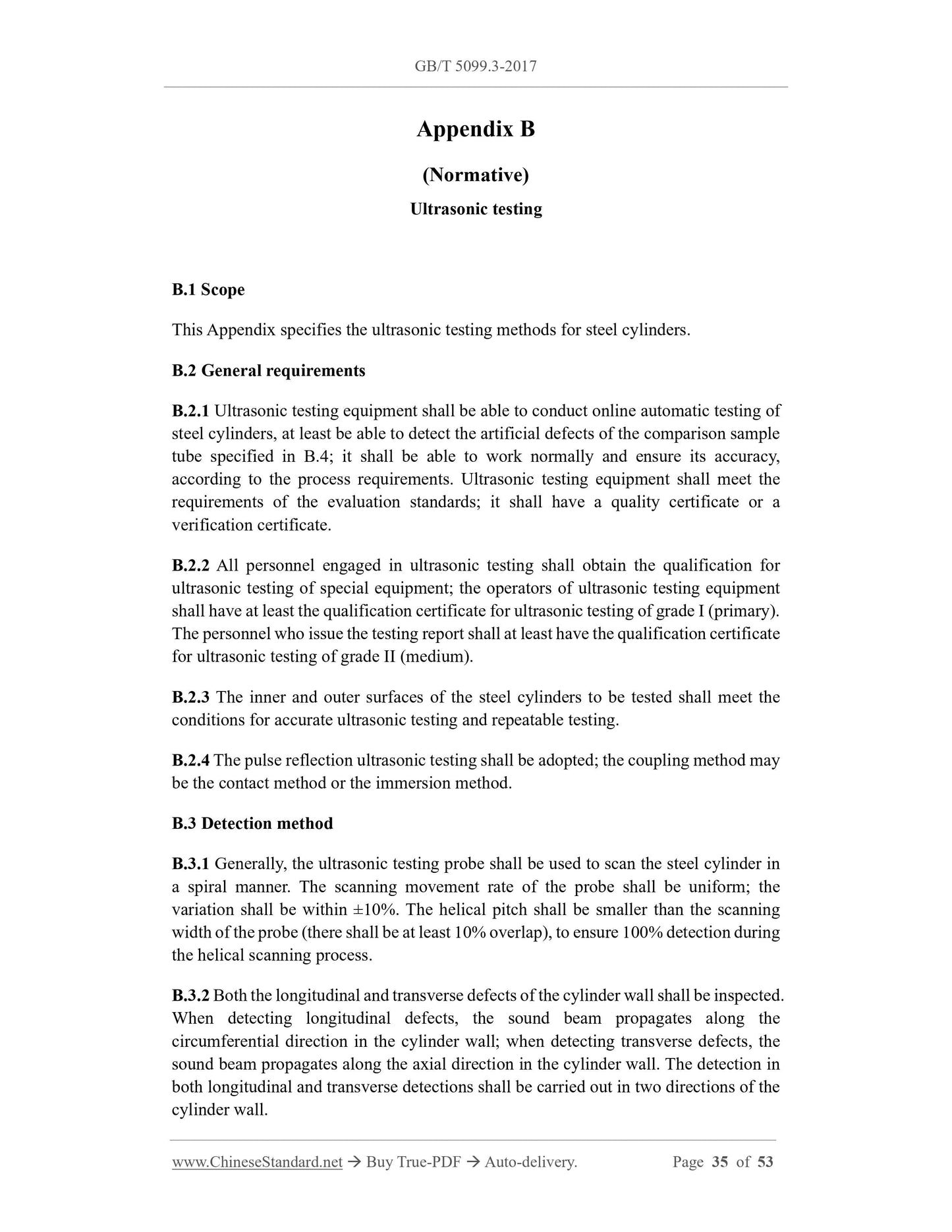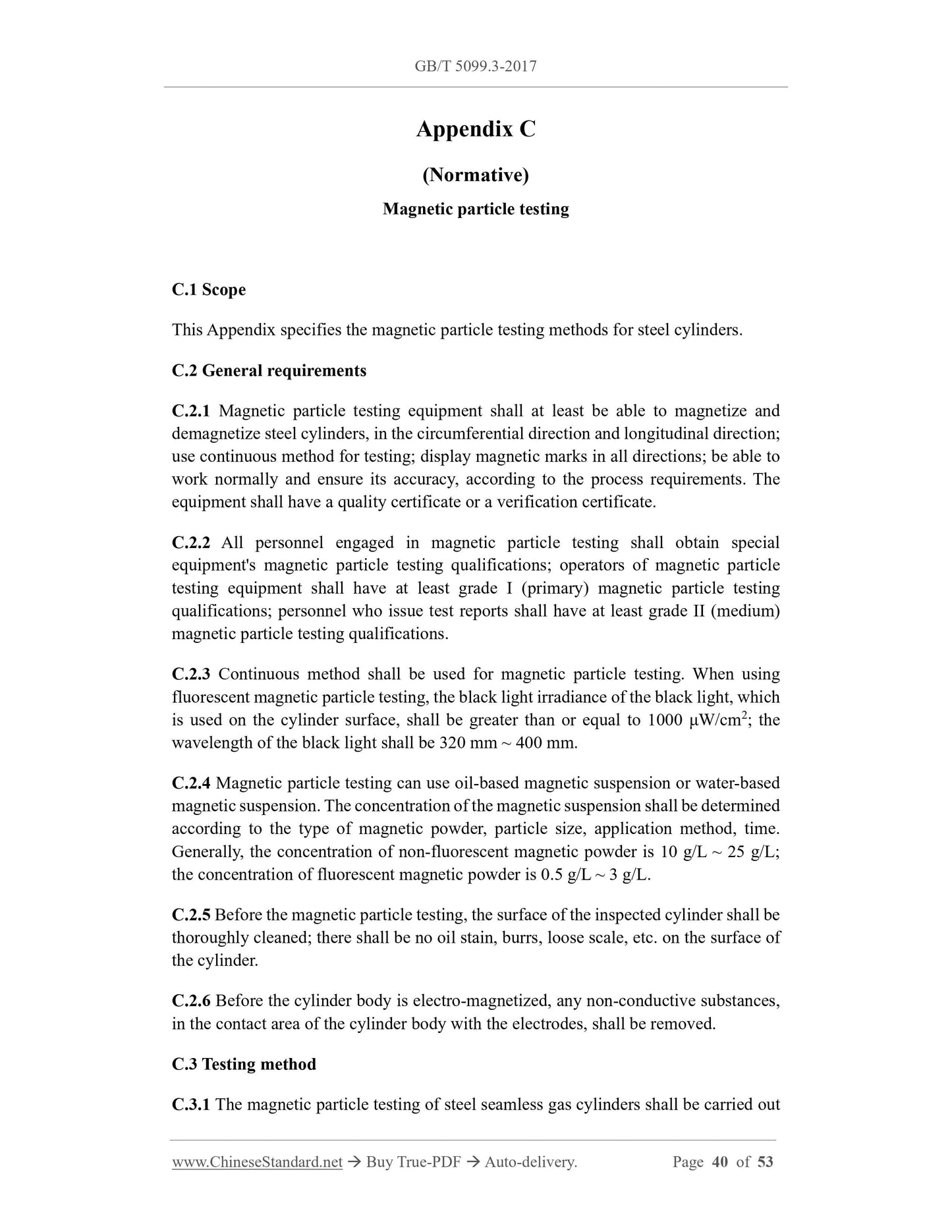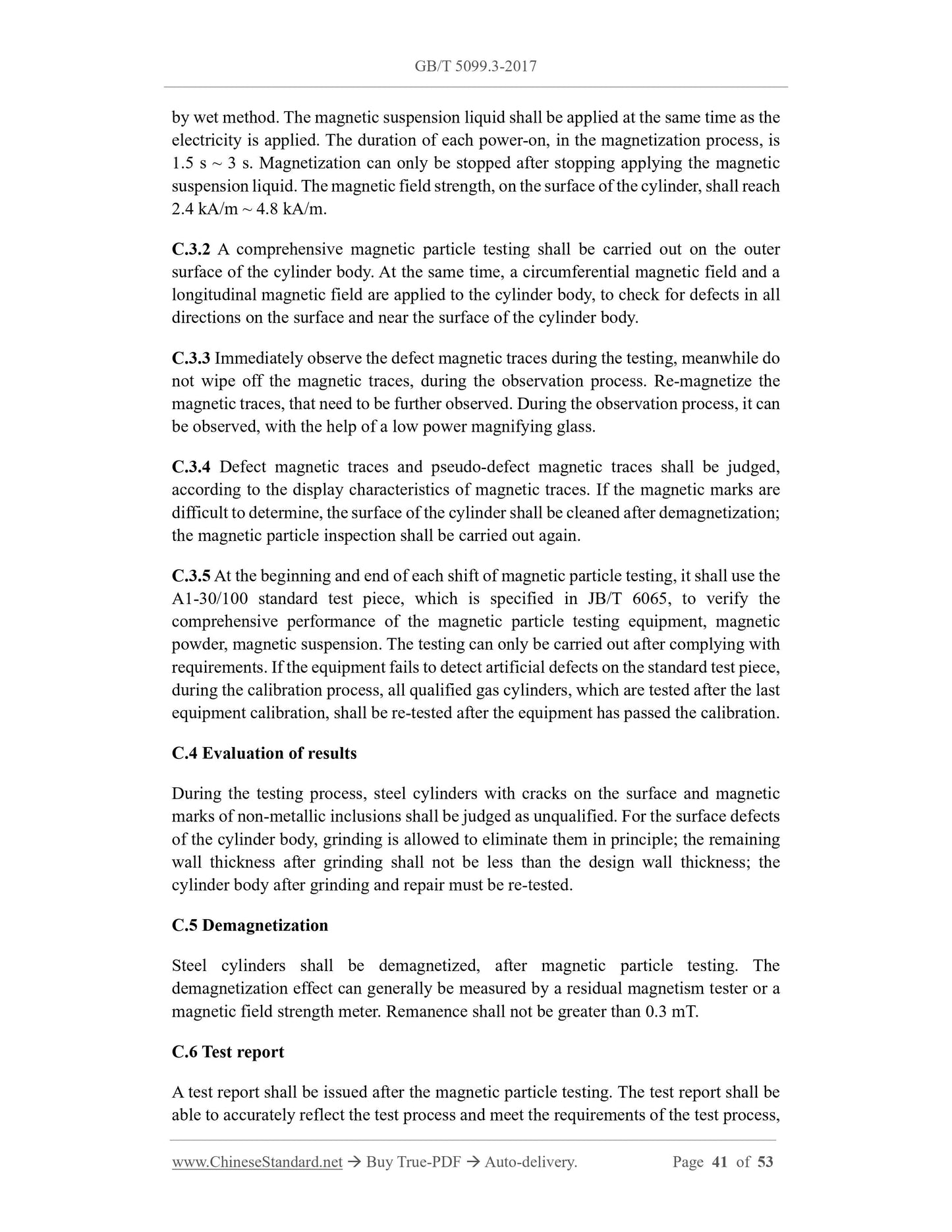1
/
of
12
PayPal, credit cards. Download editable-PDF & invoice in 1 second!
GB/T 5099.3-2017 English PDF (GBT5099.3-2017)
GB/T 5099.3-2017 English PDF (GBT5099.3-2017)
Regular price
$395.00 USD
Regular price
Sale price
$395.00 USD
Unit price
/
per
Shipping calculated at checkout.
Couldn't load pickup availability
Delivery: 3 seconds. Download true-PDF + Invoice.
Get QUOTATION in 1-minute: Click GB/T 5099.3-2017
Historical versions: GB/T 5099.3-2017
Preview True-PDF (Reload/Scroll if blank)
GB/T 5099.3-2017: Seamless steel gas cylinders -- Part 3: Normalized cylinders
GB/T 5099.3-2017
GB
NATIONAL STANDARD OF THE
PEOPLE’S REPUBLIC OF CHINA
ICS 23.020.30
J 74
Replacing GB/T 5099-1994
Seamless steel gas cylinders - Part 3: Normalized cylinders
(ISO 9809-3:2010, Gas cylinders - Refillable seamless steel gas cylinders - Design,
construction and testing - Part 3: Normalized steel cylinders, NEQ)
ISSUED ON: DECEMBER 29, 2017
IMPLEMENTED ON: JANUARY 01, 2019
Issued by: General Administration of Quality Supervision, Inspection and
Quarantine of PRC.
Standardization Administration of PRC.
Table of Contents
Foreword ... 3
1 Scope ... 5
2 Normative references ... 5
3 Terms and definitions, symbols ... 6
4 Types and parameters ... 8
5 Technical requirements ... 10
6 Test method ... 16
7 Inspection rules ... 23
8 Marking, coating, packaging, transportation, storage ... 30
9 Product certificate and batch inspection quality certificate ... 32
Appendix A (Informative) Cylinder valve assembly torque ... 34
Appendix B (Normative) Ultrasonic testing ... 35
Appendix C (Normative) Magnetic particle testing ... 40
Appendix D (Normative) Flattening test method ... 43
Appendix E (Informative) Description and judgment of internal and external surface
defects ... 47
Appendix F (Informative) Quality certificate for batch inspection of steel seamless gas
cylinders ... 52
Seamless steel gas cylinders - Part 3: Normalized cylinders
1 Scope
This Part of GB/T 5099 specifies the types and parameters, technical requirements, test
methods, inspection rules, marks, coating, packaging, transportation, storage, product
qualification certificate, batch inspection quality certificate of seamless steel gas
cylinders, after normalizing or post-normalizing tempering treatment (hereinafter
referred to as steel cylinder).
This Part is applicable to the design and manufacture of refillable steel cylinders, which
have a nominal working pressure not greater than 15 MPa, a nominal water volume of
0.5 L ~ 150 L, an ambient temperature of use at -20 °C ~ 60 °C, for holding compressed
gas or high-pressure liquefied gas.
This Part does not apply to vehicle gas cylinders and cylinder-type pressure vessels
attached to machinery and equipment.
Note: For steel seamless gas cylinders, which have a nominal water volume of less than 0.5 L,
it can also be manufactured and inspected with reference to this Part.
2 Normative references
The following documents are essential to the application of this document. For the dated
documents, only the versions with the dates indicated are applicable to this document;
for the undated documents, only the latest version (including all the amendments) is
applicable to this standard.
GB/T 196 General purpose metric screw threads - Basic dimensions (ISO 724)
GB/T 197 General purpose metric screw threads - Tolerances (ISO 965-1)
GB/T 222 Permissible tolerances for chemical composition of steel products
GB/T 223 (all parts) Methods for chemical analysis of iron, steel and alloy
GB/T 224 Determination of depth of decarburization of steels (ISO 3887)
GB/T 228.1 Metallic materials - Tensile testing - Part 1: Method of test at room
temperature (ISO 6892)
GB/T 229 Metallic materials - Charpy pendulum impact test method (ISO 148-1)
When the steel cylinder is designed with a bottom ring structure, it shall be ensured that
the bottom ring has sufficient strength, meanwhile the material of the bottom ring shall
be compatible with the material of the cylinder body. The shape of the bottom ring shall
be cylindrical, which can ensure the stability of the cylinder. The connection between
the bottom ring and the cylinder body must not be welded; its structure must not cause
water accumulation.
5.2.6 Neck ring design
When the steel cylinder is designed with a neck ring, it shall be ensured that the neck
ring has sufficient strength, meanwhile the material of the neck ring shall be compatible
with the material of the cylinder body. The connection between the neck ring and the
cylinder body must not use welding methods. The axial pull-off force of the neck ring
shall not be less than 10 times the weight of the empty cylinder AND not less than 1000
N; the anti-rotation torque shall not be less than 100 N·m.
5.3 Manufacturing
5.3.1 General requirements
5.3.1.1 The manufacture of steel cylinders shall comply with the provisions of this Part,
product drawings, relevant technical documents.
5.3.1.2 The cylinder body generally adopts the following manufacturing methods:
a) Using steel billet as raw material, it is made by drawing, stretching, sealing,
referred to as drawn cylinder;
b) It is made of seamless steel pipes after closing the bottom and mouth, referred to
as pipe cylinders.
5.3.1.3 The chemical composition of the steel cylinder shall be analyzed and verified,
according to the furnace number of the material, before manufacture. The analysis
method shall be carried out, according to GB/T 223 or GB/T 4336; the result shall meet
the requirements of 5.1.
5.3.1.4 Steel cylinders are not allowed to be welded. Defects such as cracks, inclusions,
lack of fusion on the inner surface of the bottom of the pipe cylinder shall be removed,
by mechanical milling or other methods.
5.3.1.5 It is allowed to use special tools for grinding the surface defects of the cylinder
body; the grinding slope is not greater than 1:3.
5.3.2 Group batching
Manufacture shall be managed in batches; the quantity of each batch shall not exceed
500 plus the number of cylinders used for destructive tests.
5.3.3 Heat treatment
The body of the steel cylinder shall be heat treated as a whole; the heat treatment shall
be carried out, according to the qualified normalizing or post-normalizing tempering.
5.3.4 Non-destructive testing
Non-destructive testing shall be carried out one by one, after the cylinder body is heat
treated.
5.3.5 Hydrostatic test
The cylinder body shall be hydrostatically tested one by one; the inner surface shall be
dried after the hydrostatic test; there shall be no residual water stains.
5.3.6 Cylinder mouth thread
The profile, size, tolerance of the cylinder mouth thread shall comply with the
provisions of GB/T 8335 or relevant standards.
5.3.7 Accessories
5.3.7.1 Select and match the corresponding cylinder valves, according to the nature of
the gas to be filled. For the control of assembly torque of tapered screw cylinder valves
and common thread cylinder valves, refer to the requirements in Table A.1 and Table
A.2 in Appendix A.
5.3.7.2 Steel cylinders shall generally be delivered with caps or shields. The caps or
shields can be fixed or detachable. They can be made of metal or resin, which can resist
the impact of external forces.
5.3.7.3 For accessories that use threaded connections, the profile, size, tolerance shall
comply with the provisions of GB/T 8335 or relevant standards.
6 Test method
6.1 Wall thickness and manufacturing tolerances
6.1.1 The thickness of the cylinder body shall be measured by an ultrasonic thickness
gauge.
6.1.2 The manufacturing tolerance of the cylinder is inspected by standard measuring
tools or special measuring tools and templates. The inspection items include the average
outer diameter, roundness, perpendicularity, straightness of the cylinder.
6.2 Bottom tightness test
Use an appropriate test device, to pressurize the central area of the inner surface of the
bottom of the cylinder. The pressurized area shall be a...
Get QUOTATION in 1-minute: Click GB/T 5099.3-2017
Historical versions: GB/T 5099.3-2017
Preview True-PDF (Reload/Scroll if blank)
GB/T 5099.3-2017: Seamless steel gas cylinders -- Part 3: Normalized cylinders
GB/T 5099.3-2017
GB
NATIONAL STANDARD OF THE
PEOPLE’S REPUBLIC OF CHINA
ICS 23.020.30
J 74
Replacing GB/T 5099-1994
Seamless steel gas cylinders - Part 3: Normalized cylinders
(ISO 9809-3:2010, Gas cylinders - Refillable seamless steel gas cylinders - Design,
construction and testing - Part 3: Normalized steel cylinders, NEQ)
ISSUED ON: DECEMBER 29, 2017
IMPLEMENTED ON: JANUARY 01, 2019
Issued by: General Administration of Quality Supervision, Inspection and
Quarantine of PRC.
Standardization Administration of PRC.
Table of Contents
Foreword ... 3
1 Scope ... 5
2 Normative references ... 5
3 Terms and definitions, symbols ... 6
4 Types and parameters ... 8
5 Technical requirements ... 10
6 Test method ... 16
7 Inspection rules ... 23
8 Marking, coating, packaging, transportation, storage ... 30
9 Product certificate and batch inspection quality certificate ... 32
Appendix A (Informative) Cylinder valve assembly torque ... 34
Appendix B (Normative) Ultrasonic testing ... 35
Appendix C (Normative) Magnetic particle testing ... 40
Appendix D (Normative) Flattening test method ... 43
Appendix E (Informative) Description and judgment of internal and external surface
defects ... 47
Appendix F (Informative) Quality certificate for batch inspection of steel seamless gas
cylinders ... 52
Seamless steel gas cylinders - Part 3: Normalized cylinders
1 Scope
This Part of GB/T 5099 specifies the types and parameters, technical requirements, test
methods, inspection rules, marks, coating, packaging, transportation, storage, product
qualification certificate, batch inspection quality certificate of seamless steel gas
cylinders, after normalizing or post-normalizing tempering treatment (hereinafter
referred to as steel cylinder).
This Part is applicable to the design and manufacture of refillable steel cylinders, which
have a nominal working pressure not greater than 15 MPa, a nominal water volume of
0.5 L ~ 150 L, an ambient temperature of use at -20 °C ~ 60 °C, for holding compressed
gas or high-pressure liquefied gas.
This Part does not apply to vehicle gas cylinders and cylinder-type pressure vessels
attached to machinery and equipment.
Note: For steel seamless gas cylinders, which have a nominal water volume of less than 0.5 L,
it can also be manufactured and inspected with reference to this Part.
2 Normative references
The following documents are essential to the application of this document. For the dated
documents, only the versions with the dates indicated are applicable to this document;
for the undated documents, only the latest version (including all the amendments) is
applicable to this standard.
GB/T 196 General purpose metric screw threads - Basic dimensions (ISO 724)
GB/T 197 General purpose metric screw threads - Tolerances (ISO 965-1)
GB/T 222 Permissible tolerances for chemical composition of steel products
GB/T 223 (all parts) Methods for chemical analysis of iron, steel and alloy
GB/T 224 Determination of depth of decarburization of steels (ISO 3887)
GB/T 228.1 Metallic materials - Tensile testing - Part 1: Method of test at room
temperature (ISO 6892)
GB/T 229 Metallic materials - Charpy pendulum impact test method (ISO 148-1)
When the steel cylinder is designed with a bottom ring structure, it shall be ensured that
the bottom ring has sufficient strength, meanwhile the material of the bottom ring shall
be compatible with the material of the cylinder body. The shape of the bottom ring shall
be cylindrical, which can ensure the stability of the cylinder. The connection between
the bottom ring and the cylinder body must not be welded; its structure must not cause
water accumulation.
5.2.6 Neck ring design
When the steel cylinder is designed with a neck ring, it shall be ensured that the neck
ring has sufficient strength, meanwhile the material of the neck ring shall be compatible
with the material of the cylinder body. The connection between the neck ring and the
cylinder body must not use welding methods. The axial pull-off force of the neck ring
shall not be less than 10 times the weight of the empty cylinder AND not less than 1000
N; the anti-rotation torque shall not be less than 100 N·m.
5.3 Manufacturing
5.3.1 General requirements
5.3.1.1 The manufacture of steel cylinders shall comply with the provisions of this Part,
product drawings, relevant technical documents.
5.3.1.2 The cylinder body generally adopts the following manufacturing methods:
a) Using steel billet as raw material, it is made by drawing, stretching, sealing,
referred to as drawn cylinder;
b) It is made of seamless steel pipes after closing the bottom and mouth, referred to
as pipe cylinders.
5.3.1.3 The chemical composition of the steel cylinder shall be analyzed and verified,
according to the furnace number of the material, before manufacture. The analysis
method shall be carried out, according to GB/T 223 or GB/T 4336; the result shall meet
the requirements of 5.1.
5.3.1.4 Steel cylinders are not allowed to be welded. Defects such as cracks, inclusions,
lack of fusion on the inner surface of the bottom of the pipe cylinder shall be removed,
by mechanical milling or other methods.
5.3.1.5 It is allowed to use special tools for grinding the surface defects of the cylinder
body; the grinding slope is not greater than 1:3.
5.3.2 Group batching
Manufacture shall be managed in batches; the quantity of each batch shall not exceed
500 plus the number of cylinders used for destructive tests.
5.3.3 Heat treatment
The body of the steel cylinder shall be heat treated as a whole; the heat treatment shall
be carried out, according to the qualified normalizing or post-normalizing tempering.
5.3.4 Non-destructive testing
Non-destructive testing shall be carried out one by one, after the cylinder body is heat
treated.
5.3.5 Hydrostatic test
The cylinder body shall be hydrostatically tested one by one; the inner surface shall be
dried after the hydrostatic test; there shall be no residual water stains.
5.3.6 Cylinder mouth thread
The profile, size, tolerance of the cylinder mouth thread shall comply with the
provisions of GB/T 8335 or relevant standards.
5.3.7 Accessories
5.3.7.1 Select and match the corresponding cylinder valves, according to the nature of
the gas to be filled. For the control of assembly torque of tapered screw cylinder valves
and common thread cylinder valves, refer to the requirements in Table A.1 and Table
A.2 in Appendix A.
5.3.7.2 Steel cylinders shall generally be delivered with caps or shields. The caps or
shields can be fixed or detachable. They can be made of metal or resin, which can resist
the impact of external forces.
5.3.7.3 For accessories that use threaded connections, the profile, size, tolerance shall
comply with the provisions of GB/T 8335 or relevant standards.
6 Test method
6.1 Wall thickness and manufacturing tolerances
6.1.1 The thickness of the cylinder body shall be measured by an ultrasonic thickness
gauge.
6.1.2 The manufacturing tolerance of the cylinder is inspected by standard measuring
tools or special measuring tools and templates. The inspection items include the average
outer diameter, roundness, perpendicularity, straightness of the cylinder.
6.2 Bottom tightness test
Use an appropriate test device, to pressurize the central area of the inner surface of the
bottom of the cylinder. The pressurized area shall be a...
Share
